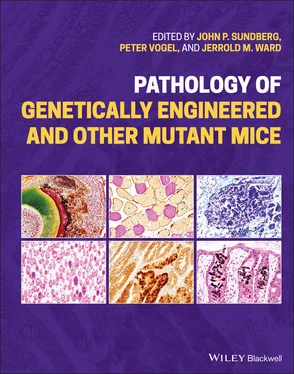Pathology of Genetically Engineered and Other Mutant Mice
Здесь есть возможность читать онлайн «Pathology of Genetically Engineered and Other Mutant Mice» — ознакомительный отрывок электронной книги совершенно бесплатно, а после прочтения отрывка купить полную версию. В некоторых случаях можно слушать аудио, скачать через торрент в формате fb2 и присутствует краткое содержание. Жанр: unrecognised, на английском языке. Описание произведения, (предисловие) а так же отзывы посетителей доступны на портале библиотеки ЛибКат.
- Название:Pathology of Genetically Engineered and Other Mutant Mice
- Автор:
- Жанр:
- Год:неизвестен
- ISBN:нет данных
- Рейтинг книги:3 / 5. Голосов: 1
-
Избранное:Добавить в избранное
- Отзывы:
-
Ваша оценка:
- 60
- 1
- 2
- 3
- 4
- 5
Pathology of Genetically Engineered and Other Mutant Mice: краткое содержание, описание и аннотация
Предлагаем к чтению аннотацию, описание, краткое содержание или предисловие (зависит от того, что написал сам автор книги «Pathology of Genetically Engineered and Other Mutant Mice»). Если вы не нашли необходимую информацию о книге — напишите в комментариях, мы постараемся отыскать её.
An updated and comprehensive reference to pathology in every organ system in genetically modified mice Pathology of Genetically Engineered and Other Mutant Mice
Pathology of Genetically Engineered and Other Mutant Mice
Pathology of Genetically Engineered and Other Mutant Mice — читать онлайн ознакомительный отрывок
Ниже представлен текст книги, разбитый по страницам. Система сохранения места последней прочитанной страницы, позволяет с удобством читать онлайн бесплатно книгу «Pathology of Genetically Engineered and Other Mutant Mice», без необходимости каждый раз заново искать на чём Вы остановились. Поставьте закладку, и сможете в любой момент перейти на страницу, на которой закончили чтение.
Интервал:
Закладка:
18 18 Petiet, A.E., Kaufman, M.H., Goddeeris, M.M. et al. (2008). High‐resolution magnetic resonance histology of the embryonic and neonatal mouse: a 4D atlas and morphologic database. Proc. Natl. Acad. Sci. U.S.A. 105 (34): 12331–12336.
19 19 Savolainen, S.M., Foley, J.F., and Elmore, S.A. (2009). Histology atlas of the developing mouse heart with emphasis on E11.5 to E18.5. Toxicol. Pathol. 37 (4): 395–414.
20 20 Crawford, L.W., Foley, J.F., and Elmore, S.A. (2010). Histology atlas of the developing mouse hepatobiliary system with emphasis on embryonic days 9.5–18.5. Toxicol. Pathol. 38 (6): 872–906.
21 21 Bolon, B., Couto, S., Fiette, L., and Perle, K.L. (2012). Internet and print resources to facilitate pathology analysis when phenotyping genetically engineered rodents. Vet. Pathol. 49 (1): 224–235.
22 22 Ward, J.M., Elmore, S.A., and Foley, J.F. (2012). Pathology methods for the evaluation of embryonic and perinatal developmental defects and lethality in genetically engineered mice. Vet. Pathol. 49 (1): 71–84.
23 23 Swartley, O.M., Foley, J.F., Livingston, D.P. 3rd et al. (2016). Histology atlas of the developing mouse hepatobiliary hemolymphatic vascular system with emphasis on embryonic days 11.5–18.5 and early postnatal development. Toxicol. Pathol. 44 (5): 705–725.
24 24 Chen, V.S., Morrison, J.P., Southwell, M.F. et al. (2017). Histology atlas of the developing prenatal and postnatal mouse central nervous system, with emphasis on prenatal days E7.5 to E18.5. Toxicol. Pathol. 45 (6): 705–744.
25 25 Elmore, S.A., Kavari, S.L., Hoenerhoff, M.J. et al. (2019). Histology atlas of the developing mouse urinary system with emphasis on prenatal days E10.5–E18.5. Toxicol. Pathol. 47 (7): 865–886.
26 26 Furukawa, S., Tsuji, N., and Sugiyama, A. (2019). Morphology and physiology of rat placenta for toxicological evaluation. J. Toxicol. Pathol. 32 (1): 1–17.
27 27 Elmore, S.A., Cochran, Z., Bolon, B. et al. (2021). Histology atlas of the developing mouse placenta. Toxicol. Pathol. (in press).
28 28 Clancy, B., Charvet, C.J., Darlington, R.B. et al. (2013). Translating time (across developing mammalian brains). http://translatingtime.net(accessed 15 March 2020).
29 29 Hill, M.A. (2014). Mouse development. University of New South Wales. https://embryology.med.unsw.edu.au/embryology/index.php/Mouse_Timeline_Detailed(accessed 15 July 2021).
30 30 Sulik, K.K. and Bream, P.R.J. Embryo images: normal and abnormal mammalian development. Chapel Hill, NC: University of North Carolina. Not given. http://www.med.unc.edu/embryo_images/(accessed 15 July 2021).
31 31 Butler, H. and Juurlink, B.H.J. (1987). An Atlas for Staging Mammalian and Chick Embryos. Boca Raton, FL: CRC Press.
32 32 Kaufman, M.H. and Bard, J.B.L. (1999). The Anatomical Basis of Mouse Development. San Diego, CA: Academic Press.
33 33 Thiel, R., Chahoud, I., Jürgens, M., and Neubert, D. (1993). Time‐dependent differences in the development of somites of four different mouse strains. Teratog., Carcinog., Mutagen. 13 (6): 247–257.
34 34 Malle, D., Economou, L., Sioga, A. et al. (2004). Somitogenesis in different mouse strains. Folia Anat. 32 (1): 5–10.
35 35 Paria, B.C., Lim, H., Das, S.K. et al. (2000). Molecular signaling in uterine receptivity for implantation. Semin. Cell Dev. Biol. 11 (2): 67–76.
36 36 Ramathal, C.Y., Bagchi, I.C., Taylor, R.N., and Bagchi, M.K. (2010). Endometrial decidualization: of mice and men. Semin. Reprod. Med. 28 (1): 17–26.
37 37 Spencer, T.E. and Bazer, F.W. (2004). Conceptus signals for establishment and maintenance of pregnancy. Reprod. Biol. Endocrinol. 2: 49.
38 38 O'Neill, C., Li, Y., and Jin, X.L. (2012). Survival signaling in the preimplantation embryo. Theriogenology 77 (4): 773–784.
39 39 Bolon, B. and Ward, J.M. (2015). Anatomy and physiology of the developing mouse and placenta. In: Pathology of the Developing Mouse: A Systematic Approach (ed. B. Bolon), 39–98. Boca Raton, FL: CRC Press (Taylor & Francis).
40 40 Warkany, J. (1971). Sensitive or critical periods in teratogenesis: uses and abuses of embryologic timetables. In: Congenital Malformations (ed. J. Warkany), 49–52. Chicago, IL: Year Book Medical Publishing, Inc.
41 41 Daston, G.P. and Manson, J.M. (1995). Critical periods of exposure and developmental outcome. Inhalation Toxicol. 7 (6): 863–871.
42 42 Rodier, P.M. (1980). Chronology of neuron development: animal studies and their clinical implications. Dev. Med. Child Neurol. 22 (4): 525–545.
43 43 Turgeon, B. and Meloche, S. (2009). Interpreting neonatal lethal phenotypes in mouse mutants: insights into gene function and human diseases. Physiol. Rev. 89 (1): 1–26.
44 44 Ward, J.M. and Devor‐Henneman, D.E. (2000). Gestational mortality in genetically engineered mice: evaluating the extraembryonal embryonic placenta and membranes. In: Pathology of Genetically Engineered Mice (eds. J.M. Ward, J.F. Mahler, R.R. Maronpot, et al.), 103–122. Ames, IA: Iowa State University Press.
45 45 Georgiades, P., Ferguson‐Smith, A.C., and Burton, G.J. (2002). Comparative developmental anatomy of the murine and human definitive placentae. Placenta 23 (1): 3–19.
46 46 Jollie, W.P. (1990). Development, morphology, and function of the yolk‐sac placenta of laboratory rodents. Teratology 41 (4): 361–381.
47 47 Adamson, S.L., Lu, Y., Whiteley, K.J. et al. (2002). Interactions between trophoblast cells and the maternal and fetal circulation in the mouse placenta. Dev. Biol. 250 (2): 358–373.
48 48 Coan, P.M., Conroy, N., Burton, G.J., and Ferguson‐Smith, A.C. (2006). Origin and characteristics of glycogen cells in the developing murine placenta. Dev. Dyn. 235 (12): 3280–3294.
49 49 Pijnenborg, R. (2000). The metrial gland is more than a mesometrial lymphoid aggregate of pregnancy. J. Reprod. Immunol. 46 (1): 17–19.
50 50 Ain, R. and Soares, M.J. (2004). Is the metrial gland really a gland? J. Reprod. Immunol. 61 (2): 129–131.
51 51 Croy, B.A., van den Heuvel, M.J., Borzychowski, A.M., and Tayade, C. (2006). Uterine natural killer cells: a specialized differentiation regulated by ovarian hormones. Immunol. Rev. 214 (1): 161–185.
52 52 Picut, C.A., Swanson, C.L., Parker, R.F. et al. (2009). The metrial gland in the rat and its similarities to granular cell tumors. Toxicol. Pathol. 37 (4): 474–480.
53 53 Croy, B.A., Zhang, J., Tayade, C. et al. (2010). Analysis of uterine natural killer cells in mice. Methods Mol. Biol. 612: 465–503.
54 54 Plaks, V., Sapoznik, S., Berkovitz, E. et al. (2011). Functional phenotyping of the maternal albumin turnover in the mouse placenta by dynamic contrast‐enhanced MRI. Mol. Imag. Biol. 13 (3): 481–492.
55 55 McLaren, A. (1965). Genetic and environmental effects on foetal and placental growth in mice. J. Reprod. Fertil. 9: 79–89.
56 56 Tanaka, S., Oda, M., Toyoshima, Y. et al. (2001). Placentomegaly in cloned mouse concepti caused by expansion of the spongiotrophoblast layer. Biol. Reprod. 65 (6): 1813–1821.
57 57 George, J.D. and Manson, J.M. (1986). Strain‐dependent differences in the metabolism of 3‐methylcholanthrene by maternal, placental, and fetal tissues of C57BL/6J and DBA/2J mice. Cancer Res. 46 (11): 5671–5675.
58 58 Bolon, B., Newbigging, S., and Boyd, K.L. (2017). Pathology evaluation of developmental phenotypes in neonatal and juvenile mice. Curr. Protoc. Mouse Biol. 7 (3): 191–219.
59 59 Ince, T.A., Ward, J.M., Valli, V.E. et al. (2008). Do‐it‐yourself (DIY) pathology. Nat. Biotechnol. 26 (9): 978–979. discussion 9.
60 60 Bolon, B., Garman, R., Jensen, K. et al. (2006). A ‘best practices’ approach to neuropathologic assessment in developmental neurotoxicity testing—for today. Toxicol. Pathol. 34 (3): 296–313.
Читать дальшеИнтервал:
Закладка:
Похожие книги на «Pathology of Genetically Engineered and Other Mutant Mice»
Представляем Вашему вниманию похожие книги на «Pathology of Genetically Engineered and Other Mutant Mice» списком для выбора. Мы отобрали схожую по названию и смыслу литературу в надежде предоставить читателям больше вариантов отыскать новые, интересные, ещё непрочитанные произведения.
Обсуждение, отзывы о книге «Pathology of Genetically Engineered and Other Mutant Mice» и просто собственные мнения читателей. Оставьте ваши комментарии, напишите, что Вы думаете о произведении, его смысле или главных героях. Укажите что конкретно понравилось, а что нет, и почему Вы так считаете.












